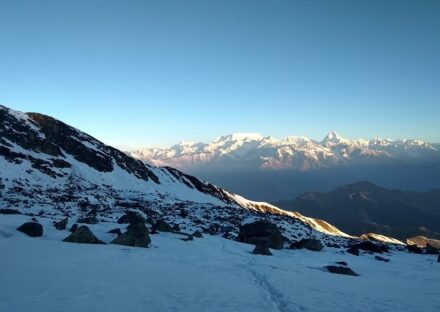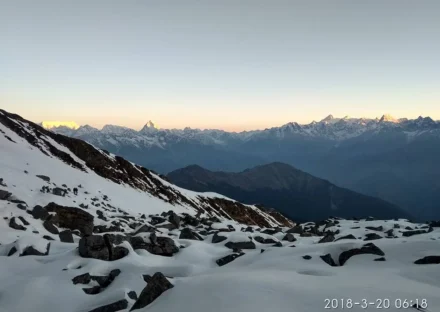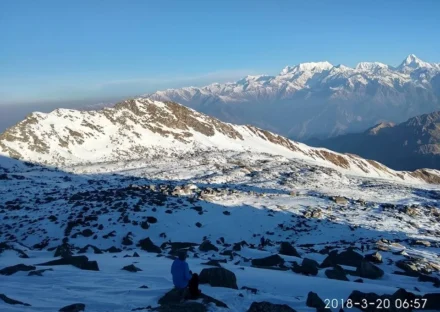- Details
- Itinerary
- Photos
Tour overview
Pangarchulla Trek Package Uttarakhand Only @₹13500/- Book Now
*GST Included – No Hidden or Extra Charges.
Pangarchulla Trek: An Adventure-Packed Summit Climb
Pangarchulla Trek is one of the most popular treks in the Indian state of Uttarakhand. This moderate to challenging walk takes you through some of the most beautiful Himalayan scenery.
The trek starts from the quaint village of Joshimath and passes through dense forests, open meadows, and high-altitude mountain passes.
The highlight of the Pangarchulla Trek is the summit climb to the Pangarchulla Peak, which stands tall at an altitude of 4,700 meters. The summit climb is challenging and requires a good level of physical fitness and acclimatization. However, the stunning views of the Himalayan peaks from the summit make it all worth it.
The Pangarchulla Trek is also known for its diverse flora and fauna. You will travel through Nanda Devi National Park, a UNESCO World Heritage Site, on this journey.
The best time to undertake the Pangarchulla Trek is from April to June and September to November when the weather is pleasant and the skies are clear. The walk may be finished in 6-7 days, and it is recommended to go with a licensed trekking organization that offers knowledgeable guides, camping gear, and other essential facilities.
Overall, the Pangarchulla Trek is a must-do for adventure seekers and nature lovers who want to experience the stunning beauty of the Himalayas and challenge themselves in a unique and rewarding way.
Why Pangarchulla Trek?
The Pangarchulla Trek is an incredibly important trek for adventure enthusiasts and nature lovers alike. In Uttarakhand, India, this journey travels through some of the region’s greatest beauty, visiting beautiful towns, and green forests, and seeing breathtaking Himalayan views.
The hike also leads to Pangarchulla Peak’s summit, which is nearly 4,000 meters high and provides stunning panoramic views of the surrounding snow-capped peaks.
The journey provides a good opportunity to learn about the local culture and way of life in addition to its natural beauty because you will meet local villages and their customs.
Overall, the Pangarchulla Trek is a must-do for anyone who wants to experience the beauty and wonder of the Himalayas, while also challenging themselves physically and mentally.
Pangarchulla Trek Highlights:
Here are some highlights of the Pangarchulla Trek:-
Stunning views: The Pangarchulla Trek offers some of the most stunning views of the Himalayan peaks, including Nanda Devi, Chaukhamba, and Hathi Parbat.
Summit of Pangarchulla Peak: The trek takes you to the top of Pangarchulla Peak, which is 4,200 meters high and offers stunning views of the valleys and peaks in the area.
Diverse terrain: The trek takes you through a diverse range of terrain, including lush forests, meadows, and rocky terrain.
Local culture: You can also learn about the local culture, customs, and way of life by talking to the villagers on the trek.
Wildlife sightings: The region is home to a variety of wildlife, including musk deer, bharal (blue sheep), and snow leopards, which can be spotted during the trek.
Campsites: The trek features several scenic campsites, including Gorson Bugyal, Khullara, and Pangarchulla Base Camp, where you can enjoy the beauty of the natural surroundings and spend a night under the stars.
Challenging but rewarding: The Pangarchulla Trek is a challenging trek, but the stunning views, diverse terrain, and unique cultural experiences make it a highly rewarding adventure.
Preparation for Pangarchulla Trek
The Pangarchulla Trek is a challenging trek that requires good physical fitness and mental preparation. To prepare for the trek, follow these steps:
- Start training at least a month before the trek: A long trek requires long walks and steep climbs, so it’s vital to train well in advance. You can begin with short walks and gradually increase the distance and intensity.
- Cardiovascular exercises: The trek requires good cardiovascular endurance, so activities like running, cycling, and swimming can be helpful in building up your stamina.
- Strength training: Strengthening exercises for the legs and core can help prepare you for the physical demands of the trek. Squats, lunges, and planks are all good exercises.
- Acclimatization: Altitude sickness can be avoided by acclimatization before a hike at high altitudes. It is recommended to spend a day or two in Joshimath or Auli before starting the trek.
- Proper gear: Trekkers should have proper trekking gear, including sturdy trekking shoes, a backpack, warm clothing, and a raincoat. A comfortable and lightweight backpack is essential to carry food, water, and other essentials during the trek.
- Medical considerations: Before starting the trek, hikers should see a doctor, particularly if they have any existing medical issues. It is advisable to carry basic first aid supplies, including medicines for altitude sickness and pain relief.
By following these tips and preparing well in advance, you can ensure a safe and enjoyable trekking experience on the Pangarchulla Trek.
Advisory for Pangarchulla Trek
Pangarchulla Trek is a popular trekking destination located in the Chamoli district of Uttarakhand, India. The trek offers spectacular views of the surrounding Himalayan peaks and is a favorite among adventure enthusiasts. However, like any other trekking expedition, the Pangarchulla trek also requires careful planning and preparation to ensure a safe and enjoyable experience. Here are some advisory tips for those planning to embark on this trek:
- Physical fitness: The Pangarchulla trek is a moderately challenging trek and requires a certain level of physical fitness. You should begin getting in shape for the walk at least a few weeks beforehand by integrating aerobic exercises like cycling or running into your regular schedule.
- Local guides: It is advisable to hire local guides for the Pangarchulla trek, as they are familiar with the terrain and weather conditions. They can also offer informative information on the region’s history and culture.
- Respect the environment: It is important to respect the environment and follow eco-friendly practices during the trek. Carry all your waste and dispose of it properly. Avoid using plastic and opt for eco-friendly alternatives.
- Weather conditions: Before beginning your trek, it’s critical to check the weather forecast because the Himalayan climate can be unpredictable. It is recommended to plan the trek during the dry season from April to June or September to November to avoid the monsoon season.
How Difficult is Pangarchulla Trek?
The Pangarchulla trek is a moderately difficult trek that requires a certain level of physical fitness and endurance. The trek involves climbing to high altitudes and navigating through steep and uneven terrain. However, with proper planning and preparation, the trek can be completed by people with moderate trekking experience.
The trek requires a gradual ascent to the high altitude, and it is essential to acclimatize properly to avoid altitude sickness. It is recommended that trekkers spend a few days in the nearby towns of Joshimath or Auli before starting the trek to adjust to the high altitude.
What is the best time for Pangarchulla Trek?
The best time to do the Pangarchulla Trek is during the months of April to June and September to November. The weather is generally pleasant and clear during these months, providing stunning views of the Himalayas.
The trekking route’s snow has melted, making it easier to navigate during the mild summer months of April through June. The days are longer, allowing for more time to explore the beautiful landscape and enjoy the stunning views.
The weather is typically clear and cool from September to November when it is dry and cool. This is the perfect time to trek as the monsoon season has ended, and the landscape is lush and green after the rains. The autumn colors of the trees add to the beauty of the trek.
The trek is not advised in the winter since the area receives an abundance of snow, which makes it challenging to follow the trekking route. Extreme cold and icy conditions can also pose a risk to trekkers.
Religious and Cultural Aspects of Pangarchulla Trek
The trek is surrounded by several ancient temples and is considered to be a sacred pilgrimage site for Hindus.
One of the Panch Kedar temples, which are regarded as the holiest shrines dedicated to Lord Shiva, is the Tungnath Temple. The Tungnath Temple, the highest Shiva temple in the world, is one of the trek’s main attractions. At an altitude of 12,073 feet is one of the Panch Kedar Temples, considered the most sacred shrine dedicated to Lord Shiva.
It was constructed by Pandavas in the Mahabharata period. As per the locals, the story behind the temple is as:
After the Kurukshetra Battle in the Mahabharata, the Pandavas needed to look for the gifts of Master Shiva to make up for their wrongdoings during the conflict. They ventured out to the Himalayas looking for Master Shiva, and on their way, they experienced a bison that was going crazy.
The buffalo was actually Lord Shiva in disguise, and he fled to the hills to avoid being caught by the Pandavas.
The Pandavas followed Lord Shiva to the hills, and he took refuge in Guptakashi, where he appeared in the form of a bull. The Pandavas recognized Lord Shiva and tried to capture him, but he disappeared into the ground, leaving behind his hump.
The hump is believed to have appeared in five different places, which are now known as the Panch Kedar temples. Tungnath is believed to be the place where Lord Shiva’s arms appeared, and hence it is considered to be a sacred pilgrimage site.
The Tungnath Temple is also associated with the story of Vyas Rishi, who is believed to have meditated at the temple. Legend has it that Vyas Rishi had a vision of Lord Shiva at the temple, who appeared in the form of a boy.
Lord Shiva then granted Vyas Rishi a boon and told him to write the Mahabharata at the temple.
Another important temple on the trek is the Kali Temple, which is located in the village of Auli. It is believed that the goddess Kali shields the villagers from natural disasters and evil spirits, which is why the temple is dedicated to her. Devotees from all over the region come to the temple to pray and seek blessings from the goddess.
The trek is surrounded by several small villages known for their distinctive culture and traditions in addition to the temples. Trekkers are warmly welcomed by the villagers, who are known for their hospitality. The villages offer a glimpse into the local way of life, and trekkers can witness traditional dance forms, music, and art. Click here to explore more about Uttarakhand Treks.
Included
- Accommodation: Enjoy 6 nights of tented lodging on a triple sharing basis.
- Meals: All vegetarian meals from breakfast to dinner for the first day to seventh day.
- Morning and evening tea/coffee are served with light snacks during the trek.
- Camping Charges: All essential fees and permits for Indian residents are covered.
- Safety Equipment: Basic first aid medical kits including an oxygen cylinder and an oximeter.
- Expert Trek Leaders: Knowledgeable and experienced trek leaders and support staff.
Not Included
- Personal Insurance
- Medical Certificate
- Personal toiletry Items and Personal Medicine kit
Day 1: Rishikesh to Joshimath
• Our expedition begins with a pickup from the tranquil town of Rishikesh, nestled along the banks of the sacred Ganges River.
• We'll embark on a scenic drive to Joshimath, our base camp, covering a distance of approximately 286 km. The journey is expected to take around 9-10 hours, allowing us ample time to soak in the breathtaking views of the Himalayan landscape.
• En route, we'll pass through Devprayag, Srinagar, Rudraprayag, Karnaprayag, and Chamoli, each offering its own unique charm and stunning vistas.
• Upon reaching Joshimath, situated at an altitude of 6152 feet, we'll check into our hotel rooms, sharing accommodation on a twin or triple basis.
Day 2: Drive to Dhak
• After a refreshing night's rest, we'll set out on a short 12 km drive from Joshimath to Dhak, the starting point of our trek.
• From Dhak, we'll begin our exhilarating trek to Gulling Camp, covering approximately 5 km on foot. The journey, spanning about 4-5 hours, will take us through verdant forests, across gurgling streams, and amidst the tranquility of the Himalayas.
• Upon reaching Gulling Camp, nestled amidst pristine natural surroundings, we'll settle into our campsite, surrounded by towering trees and panoramic mountain views.
Day 3: Gulling Top to Khullara
• Today's adventure takes us from Gulling Top to Khullara Camp, spanning roughly 7-8 kilometers with an elevation gain of 300-400 meters.
• The trek, considered moderately challenging, will lead us through alpine meadows, rocky terrain, and possibly some snow patches, offering breathtaking views of snow-capped peaks and lush valleys.
• As we ascend towards Khullara Camp, situated at an altitude of 13,989 feet, we'll be rewarded with awe-inspiring vistas of the Garhwal Himalayas.
Day 4: Khullara Camp to Pangarchulla Peak
• Gear up for a challenging yet rewarding trek from Khullara Camp to the summit of Pangarchulla Peak, standing tall at an elevation of 15,096 feet.
• The trek spans approximately 5-6 kilometers one way, with an elevation gain of 700-800 meters, and is expected to take around 8-10 hours.
• As we navigate through rocky trails, scree slopes, and possibly some snow patches, we'll be treated to unparalleled views of the surrounding Himalayan peaks, including Nanda Devi, Trishul, and Chaukhamba.
Day 5: Khullara to Dhak Roadhead
• Our journey continues from Khullara Camp to Dhak Roadhead, covering about 11 kilometers over 5-6 hours.
• Upon reaching Dhak Roadhead, we'll drive back to Joshimath, savoring the last moments of our mountain adventure.
• We'll spend the night at a hotel in Joshimath, reflecting on the unforgettable experiences and memories we've gathered along the way.
Day 6: Joshimath to Haridwar
• Our final leg of the journey takes us from Joshimath to Haridwar via Rishikesh, covering approximately 275-300 kilometers over 8-10 hours.
• As we bid farewell to the majestic Himalayas, we'll cherish the scenic views and fond memories of our expedition through the heart of Uttarakhand.





